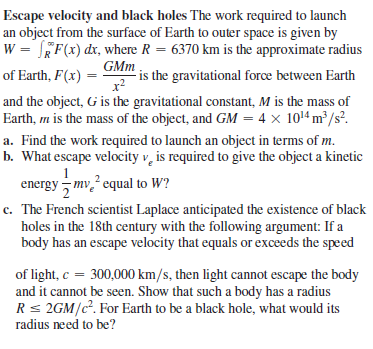Escape velocity and black holes The work required to launch an object from the surface of Earth to outer space is given by w = JEF(x) dx, where R = 6370 km is the approximate radius is the gravitational force between Earth and the object, G is the gravitational constant, M is the mass of Earth, m is the mass of the object, and GM = 4 x 1014 m²/s?. GMm of Earth, F(x) = x? a. Find the work required to launch an object in terms of m. b. What escape velocity v, is required to give the object a kinetic 1 energy mv? equal to W? c. The French scientist Laplace anticipated the existence of black holes in the 18th century with the following argument: If a body has an escape velocity that equals or exceeds the speed of light, c = 300,000 km/s, then light cannot escape the body and it cannot be seen. Show that such a body has a radius Rs 2GM/c. For Earth to be a black hole, what would its radius need to be?
Escape velocity and black holes The work required to launch an object from the surface of Earth to outer space is given by w = JEF(x) dx, where R = 6370 km is the approximate radius is the gravitational force between Earth and the object, G is the gravitational constant, M is the mass of Earth, m is the mass of the object, and GM = 4 x 1014 m²/s?. GMm of Earth, F(x) = x? a. Find the work required to launch an object in terms of m. b. What escape velocity v, is required to give the object a kinetic 1 energy mv? equal to W? c. The French scientist Laplace anticipated the existence of black holes in the 18th century with the following argument: If a body has an escape velocity that equals or exceeds the speed of light, c = 300,000 km/s, then light cannot escape the body and it cannot be seen. Show that such a body has a radius Rs 2GM/c. For Earth to be a black hole, what would its radius need to be?
College Physics
1st Edition
ISBN:9781938168000
Author:Paul Peter Urone, Roger Hinrichs
Publisher:Paul Peter Urone, Roger Hinrichs
Chapter28: Special Relativity
Section: Chapter Questions
Problem 68PE: Nuclear-powered rockets were researched for some years before safety concerns became paramount. (a)...
Related questions
Question

Transcribed Image Text:Escape velocity and black holes The work required to launch
an object from the surface of Earth to outer space is given by
w = JEF(x) dx, where R = 6370 km is the approximate radius
is the gravitational force between Earth
and the object, G is the gravitational constant, M is the mass of
Earth, m is the mass of the object, and GM = 4 x 1014 m²/s?.
GMm
of Earth, F(x) =
x?
a. Find the work required to launch an object in terms of m.
b. What escape velocity v, is required to give the object a kinetic
1
energy mv? equal to W?
c. The French scientist Laplace anticipated the existence of black
holes in the 18th century with the following argument: If a
body has an escape velocity that equals or exceeds the speed
of light, c = 300,000 km/s, then light cannot escape the body
and it cannot be seen. Show that such a body has a radius
Rs 2GM/c. For Earth to be a black hole, what would its
radius need to be?
Expert Solution
This question has been solved!
Explore an expertly crafted, step-by-step solution for a thorough understanding of key concepts.
This is a popular solution!
Trending now
This is a popular solution!
Step by step
Solved in 4 steps with 5 images

Recommended textbooks for you

College Physics
Physics
ISBN:
9781938168000
Author:
Paul Peter Urone, Roger Hinrichs
Publisher:
OpenStax College

University Physics Volume 3
Physics
ISBN:
9781938168185
Author:
William Moebs, Jeff Sanny
Publisher:
OpenStax

Principles of Physics: A Calculus-Based Text
Physics
ISBN:
9781133104261
Author:
Raymond A. Serway, John W. Jewett
Publisher:
Cengage Learning

College Physics
Physics
ISBN:
9781938168000
Author:
Paul Peter Urone, Roger Hinrichs
Publisher:
OpenStax College

University Physics Volume 3
Physics
ISBN:
9781938168185
Author:
William Moebs, Jeff Sanny
Publisher:
OpenStax

Principles of Physics: A Calculus-Based Text
Physics
ISBN:
9781133104261
Author:
Raymond A. Serway, John W. Jewett
Publisher:
Cengage Learning

Physics for Scientists and Engineers with Modern …
Physics
ISBN:
9781337553292
Author:
Raymond A. Serway, John W. Jewett
Publisher:
Cengage Learning

Physics for Scientists and Engineers
Physics
ISBN:
9781337553278
Author:
Raymond A. Serway, John W. Jewett
Publisher:
Cengage Learning

College Physics
Physics
ISBN:
9781305952300
Author:
Raymond A. Serway, Chris Vuille
Publisher:
Cengage Learning